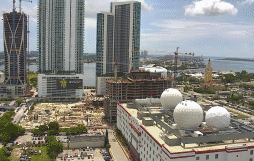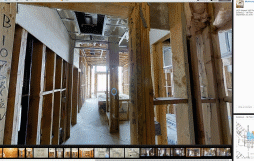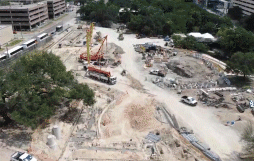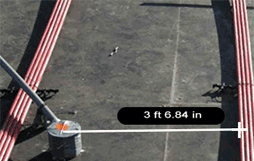Table of Contents
Technology makes it possible.
When so much of a project manager or project engineer’s attention is taken up by financials and paperwork, it’s hard to find the time to see everything that’s really happening on the project — even if that project is right outside their trailer window.
And that’s a problem. When project managers can’t walk the job often enough to verify and validate the work getting done on site, the inevitable result is quality issues. It’s no wonder 30% of the work performed by construction firms is actually rework.
Since it’s unlikely that construction professionals will get more hours in their days anytime soon, a creative solution to this problem is required. Thankfully, that solution is here, and it’s been proven to work on thousands of job sites around the world. It’s called remote monitoring.
Remote monitoring helps project management teams improve quality, decrease turnaround times, handle critical processes faster, and increase profits. In this guide, we’ll show you exactly what it takes to make it work.
Remote construction monitoring technology
The concept of “remote monitoring” might evoke images of CCTV displays, but remote monitoring technology in the construction industry is much more varied and much more sophisticated. Which technologies make it possible?
SOFTWARE
Software platforms are the window through which project managers can remotely monitor their job sites. All the other tech solutions we’ll talk about in this section can be accessed through two types of platforms: construction documentation software (Multivista) and popular project management software platforms, including Procore, PlanGrid, or Aconex.
These platforms are the foundation of an effective remote monitoring strategy. And thanks to the hard work of their respective development teams, they’ve each been integrated to make the interface between them as seamless as possible.
<!--
CONSTRUCTION PHOTOGRAPHY
Detailed photography makes it possible for every project stakeholder to walk a job site remotely. Photographs are also critical for quickly creating, responding to, and approving RFIs, submittals, change orders, observations, inspections, punch lists, daily logs... you get the picture.
Multivista offers three kinds of construction photography: progress photography (for capturing conditions at regular intervals), Exact-Built® documentation (for photographing milestones in the construction process like underground and in-slab utilities, weatherproofing, and MEP systems prior to cover-up), and measurable 3D Images for remote, on-the-spot measurements.
WEBCAMS
Webcams allow stakeholders to look in at their job sites from anywhere. The live-streaming webcams provided by Multivista capture real-time project conditions from as many different vantage points as the client desires. Some webcams even include remote pan/tilt/zoom controls to maximize visibility.
For owners, architects, and other stakeholders who don’t get a lot of face time with their projects, webcam feeds are an excellent tool for checking in on progress at a glance.
DRONES
UAV photography and video can be used to gain a bird's-eye view of a project and review progress in seconds. Drones can also be used to safely capture photos and videos of hard-to-access areas, like roofs or high-rise exteriors.
Multivista’s construction drone services also include UAV mapping. In this service, drone photographs are processed using advanced software to create interactive 2D and 3D maps of a construction site. Project managers can annotate these maps to measure distance, area, elevation, and volume right from their web browser, then export those images straight into their desired project management platform.
IMMERSIVE 3D WALKTHROUGHS
By adding a 3D virtual walkthrough service like Multivista’s Site-Walk 360° to the equation, you can “walk” the job site at any time, from anywhere. See something important? Users can create — or respond to — RFIs right from the platform.
3D walkthroughs ensure that every last angle is accounted for, giving stakeholders total immersion and total visibility into critical areas of their projects.
How remote monitoring boosts profits
When used intelligently, remote monitoring technologies can help every firm involved in a construction project improve their bottom lines. How?
Reduce quality issues.
Remote monitoring allows project managers to spend more time checking the project for issues. When they find an issue, they can look and see whether it’s isolated or systemic. The result? A more proactive approach to quality that reduces rework and saves time and money.
Reduce delays.
Oh no! There’s an issue with the height of the ductwork, and now the team is held up until we can get the design engineer to take a look. Bad news: They can’t get out to the project site again until the end of next week. With remote monitoring technology, this scenario is no problem — just have the engineer look at the issues remotely so the team can get back to business.
Hold more effective meetings.
Regular progress meetings, OAC meetings, or contractor-subcontractor meetings can all become more efficient and effective with remote monitoring. Instead of talking about high-level issues or speculating about progress, you can use your project management and construction documentation software to look at actual conditions and propose actual solutions.
Make the most of your time.
Project managers might only get a few hours a week to physically review progress on their job sites. Which areas should they focus on? With remote monitoring, PMs can identify in advance which areas need their attention, and spend their time resolving issues rather than locating them.
Save on travel.
All those planes, trains, and automobile rides required to get project stakeholders to the job site add up. Bringing people to the project gets expensive. Bringing the project to the people is much more cost-effective.
Get paid faster.
The work is done and now all that’s left to do is get paid. But before that can happen, you have to complete all those change orders, reckon them against actual site conditions, and wait for sign-off. Remote monitoring speeds up that process, making sure contractors and subcontractors get paid faster.
What does remote progress monitoring look like?

Webcam feed

Progress photography

Immersive Walkthrough

Aerial video/map

Measurable 3D Images
Learn how Darden & Company used aerial mapping to monitor progress and reduce timelines, on one of America’s biggest construction projects.
Read MoreHow remote monitoring affects critical processes
By providing architects, contractors, and owners with faster, easier ways to complete critical workflows, these technologies can significantly reduce delays, improve quality, and increase profits.
RFIs
BEFORE
Each RFI costs a construction firm an average of $1,000, and each project has hundreds (or thousands) of RFIs. The cost of this one process can mean the difference between profit and loss.
RFIs can take weeks to receive a reply, and one in four RFIs doesn’t receive a reply at all. Why? Because responding to an RFI accurately usually means making a trip to the job site.
AFTER
With Multivista's comprehensive photo documentation, construction stakeholders can quickly click into the interactive project floor plan, see everything they need to see, and use the photographic evidence to respond to the RFI. This whole process can happen remotely in moments - no site visits, no scheduling conflicts, no delays.
Submittals
BEFORE
Submittals are a tedious paperwork process that clogs up inboxes and slows down work.
What’s worse, architects and owners rarely get the opportunity to close the loop and ensure the materials that actually went in match the materials on the submittal.
AFTER
Project management software decreases friction in the submittal process, and construction photography and virtual walkthroughs enable architects and owners to finally close the loop.
After the materials have gone in, stakeholders can use Multivista’s interactive floor plans to view photographs of those materials and verify they match the submittal, improving quality and serviceability.
Observations and inspections
BEFORE
Construction professionals walk the job site at various stages to check and make sure the work that’s being done is being done right.
Unfortunately, they don’t always have time to check everything before the project has to move forward.
AFTER
While these processes almost always require an on-site presence, remote monitoring technology can make them more comprehensive.
Take observations for example. Without visual documentation, it might be impossible to examine the installation of every window on a high-rise. But with detailed UAV photographs, the observer can simply click through and observe them all from their desk
Change orders
BEFORE
Completing change orders requires verifying completion of work. Verifying completion of work requires going on site and snapping a photograph. Going on site and snapping a photograph takes time.
AFTER
With remote monitoring technology, those time and location-indexed photographs already exist, and they’re easily accessible from the interactive floorplan. With Multivista, closing out change orders is quick and easy.
Remote construction site monitoring isn’t some far-off future.
It’s a very real solution that’s been implemented on tens of thousands of real projects all over the world. As more construction firms adopt the one-two punch of visual documentation and construction project management software, remote monitoring will become a necessary component of any successful project strategy.